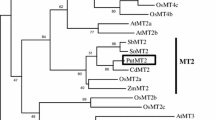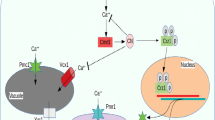Abstract
The response of Saccharomyces cerevisiae to arsenic involves a large ensemble of genes, many of which are associated with glutathione-related metabolism. The role of the glutathione S-transferase (GST) product of the URE2 gene involved in resistance of S. cerevisiae to a broad range of heavy metals was investigated. Glutathione peroxidase activity, previously reported for the Ure2p protein, was unaffected in cell-free extracts of an ure2Δ mutant of S. cerevisiae. Glutathione levels in the ure2Δ mutant were lowered about threefold compared to the isogenic wild-type strain but, as in the wild-type strain, increased 2–2.5-fold upon addition of either arsenate (AsV) or arsenite (AsIII). However, lack of URE2 specifically caused sensitivity to arsenite but not to arsenate. The protective role of URE2 against arsenite depended solely on the GST-encoding 3′-end portion of the gene. The nitrogen source used for growth was suggested to be an important determinant of arsenite toxicity, in keeping with non-enzymatic roles of the URE2 gene product in GATA-type regulation.




Similar content being viewed by others
Abbreviations
- GSTs:
-
Glutathione S-transferases
- NCR:
-
Nitrogen catabolite repression
- GPx:
-
Glutathione peroxidase
- Gdh1:
-
NADPH-dependent glutamate dehydrogenase
- Gln1:
-
Glutamine synthetase
- Gdh2:
-
NAD+-dependent glutamate dehydrogenase
References
Allocati N, Federici L, Masulli M, Di Ilio C (2009) Glutathione transferases in bacteria. FEBS J 276:58–75
Aposhian HV, Aposhian MM (2006) Arsenic toxicology: five questions. Chem Res Toxicol 19:1–15
Aposhian HV, Zakharyan RA, Avram MD, Sampayo-Reyes A, Wollenberg ML (2004) A review of the enzymology of arsenic metabolism and a new potential role of hydrogen peroxide in the detoxication of the trivalent arsenic species. Toxicol Appl Pharmacol 198:327–335
Bai M, Zhou JM, Perrett S (2004) The yeast prion protein Ure2 shows glutathione peroxidase activity in both native and fibrillar forms. J Biol Chem 279:50025–50030
Basu U, Southron JL, Stephens JL, Taylor GJ (2004) Reverse genetic analysis of the glutathione metabolic pathway suggests a novel role of PHGPX and URE2 genes in aluminum resistance in Saccharomyces cerevisiae. Mol Genet Genom 271:627–637
Bousset L, Belrhali H, Janin J, Melki R, Morera S (2001) Structure of the globular region of the prion protein Ure2 from the yeast Saccharomyces cerevisiae. Structure 9:39–46
Bun-Ya M, Shikata K, Nakade S, Yompakdee C, Harashima S, Oshima Y (1996) Two new genes, PHO86 and PHO87, involved in inorganic phosphate uptake in Saccharomyces cerevisiae. Curr Genet 29:344–351
Choi JH, Lou W, Vancura A (1998) A novel membrane-bound glutathione S-transferase functions in the stationary phase of the yeast Saccharomyces cerevisiae. J Biol Chem 273:29915–29922
Cooper TG (2002) Transmitting the signal of excess nitrogen in Saccharomyces cerevisiae from the Tor proteins to the GATA factors: connecting the dots. FEMS Microbiol Rev 26:223–238
Coschigano PW, Magasanik B (1991) The URE2 gene product of Saccharomyces cerevisiae plays an important role in the cellular response to the nitrogen source and has homology to glutathione S-transferases. Mol Cell Biol 11:822–832
Crespo JL, Daicho K, Ushimaru T, Hall MN (2001) The GATA transcription factors GLN3 and GAT1 link TOR to salt stress in Saccharomyces cerevisiae. J Biol Chem 276:34441–34444
Dang VD, Valens M, Bolotinfukuhara M, Daignanfornier B (1994) A genetic screen to isolate genes regulated by the yeast CCAAT-box binding-protein Hap2p. Yeast 10:1273–1283
Doherty D, Tabor H, White-Tabor C (1970) Glutamate dehydrogenases (yeast). Meth Enzymol 17:850–856
Frova C (2006) Glutathione transferases in the genomics era: new insights and perspectives. Biomol Eng 23:149–169
Funk M, Niedenthal R, Mumberg D, Brinkmann K, Ronicke V, Henkel T (2002) Vector systems for heterologous expression of proteins in Saccharomyces cerevisiae. Meth Enzymol 350:248–257
Georis I, Feller A, Tate JJ, Cooper TG, Dubois E (2009) Nitrogen catabolite repression-sensitive transcription of Tor pathway regulation: the genetic background, reporter gene and GATA factor assayed determine the outcomes. Genetics 181:861–874
Ghosh M, Shen J, Rosen BP (1999) Pathways of As(III) detoxification in Saccharomyces cerevisiae. Proc Natl Acad Sci USA 96:5001–5006
Haugen AC, Kelley R, Collins JB, Tucker CJ, Deng CC, Afshari CA, Brown JM, Ideker T, Van Houten B (2004) Integrating phenotypic and expression profiles to map arsenic-response networks. Genome Biol 5:R95
Hosiner D, Lempiainen H, Reiter W, Urban J, Loewith R, Ammerer G, Schweyen R, Shore D, Schuller C (2009) Arsenic toxicity to Saccharomyces cerevisiae is a consequence of inhibition of the TORC1 kinase combined with a chronic stress response. Mol Biol Cell 20:1048–1057
Ilina Y, Sloma E, Maciaszczyk-Dziubinska E, Novotny M, Thorsen M, Wysocki R, Tamás MJ (2008) Characterization of the DNA-binding motif of the arsenic-responsive transcription factor Yap8p. Biochem J 415:467–475
Lian HY, Jiang Y, Zhang H, Jones GW, Perrett S (2006) The yeast prion protein Ure2: Structure, function and folding. Biochim Biophys Acta 1764:535–545
Liu ZJ, Boles E, Rosen BP (2004) Arsenic trioxide uptake by hexose permeases in Saccharomyces cerevisiae. J Biol Chem 279:17312–17318
Lowry OH, Rosebrough NJ, Farr AL, Rabndall RJ (1951) Protein measurement with the folin phenol reagent. J Biol Chem 193:265–275
Maciaszczyk-Dziubinska E, Migdal I, Migocka M, Bocer T, Wysocki R (2010) The yeast aquaglyceroporin Fps1p is a bidirectional arsenite channel. FEBS Lett 584:726-732
Magasanik B, Kaiser CA (2002) Nitrogen regulation in Saccharomyces cerevisiae. Gene 290:1–18
Masison DC, Wickner RB (1995) Prion-inducing domain of yeast Ure2p and protease resistance of Ure2p prion-containing cells. Science 270:93–95
McGoldrick S, O’Sullivan SM, Sheehan D (2005) Glutathione transferase-like proteins encoded in genomes of yeasts and fungi: insights into evolution of a multifunctional protein superfamily. FEMS Microbiol Lett 242:1–12
Menezes RA, Amaral C, Batista-Nascimento L, Santos C, Ferreira RB, Devaux F, Eleutherio ECA, Rodrigues-Pousada C (2008) Contribution of Yap1 towards Saccharomyces cerevisiae adaptation to arsenic-mediated oxidative stress. Biochem J 414:301–311
Mukhopadhyay R, Shi J, Rosen BP (2000) Purification and characterization of Acr2p, the Saccharomyces cerevisiae arsenate reductase. J Biol Chem 275:21149–21157
Perrone GG, Grant CM, Dawes IW (2005) Genetic and environmental factors influencing glutathione homeostasis in Saccharomyces cerevisiae. Mol Biol Cell 16:218–230
Rai R, Cooper TG (2005) In vivo specificity of Ure2 protection from heavy metal ion and oxidative cellular damage in Saccharomyces cerevisiae. Yeast 22:343–358
Rai R, Tate JJ, Cooper TG (2003) Ure2, a prion precursor with homology to glutathione S-transferase, protects Saccharomyces cerevisiae cells from heavy metal ion and oxidant toxicity. J Biol Chem 278:12826–12833
Reynolds A, Lundblad V, Dorris D, Keaveney M (2001) Yeast vectors and assays for expression of cloned genes. In: Ausubel FMEA (ed) Curr Protoc Mol Biol. Wiley, New York, p Unit 13.16
Rosen BP (2002) Biochemistry of arsenic detoxification. FEBS Lett 529:86–92
Scherens B, Feller A, Vierendeels F, Messenguy F, Dubois E (2006) Identification of direct and indirect targets of the Gln3 and Gat1 activators by transcriptional profiling in response to nitrogen availability in the short and long term. FEMS Yeast Res 6:777–791
Springael JY, Penninckx MJ (2003) Nitrogen-source regulation of yeast gamma-glutamyl transpeptidase synthesis involves the regulatory network including the GATA zinc-finger factors Gln3, Nil1/Gat1 and Gzf3. Biochem J 371:589–595
Tadi D, Hasan RN, Bussereau F, Boy-Marcotte E, Jacquet M (1999) Selection of genes repressed by cAMP that are induced by nutritional limitation in Saccharomyces cerevisiae. Yeast 15:1733–1745
Tate JJ, Cooper TG (2007) Stress-responsive Gln3 localization in Saccharomyces cerevisiae is separable from and can overwhelm nitrogen source regulation. J Biol Chem 282:18467–18480
Taussky HH, Shorr E, Kurzmann G (1953) A microcolorimetric method for the determination of inorganic phosphorous. J Biol Chem 202:675–685
ter Schure EG, van Riel NAW, Verrips CT (2000) The role of ammonia metabolism in nitrogen catabolite repression in Saccharomyces cerevisiae. FEMS Microbiol Rev 24:67–83
Thorsen M, Di YJ, Tangemo C, Morillas M, Ahmadpour D, Van der Does C, Wagner A, Johansson E, Boman J, Posas F, Wysocki R, Tamás MJ (2006) The MAPK Hog1p modulates Fps1p-dependent arsenite uptake and tolerance in yeast. Mol Biol Cell 17:4400–4410
Thorsen M, Lagniel G, Kristiansson E, Junot C, Nerman O, Labarre J, Tamás MJ (2007) Quantitative transcriptome, proteome, and sulfur metabolite profiling of the Saccharomyces cerevisiae response to arsenite. Physiol Genom 30:35–43
Thorsen M, Perrone GG, Kristiansson E, Traini M, Ye T, Dawes IW, Nerman O, Tamás MJ (2009) Genetic basis of arsenite and cadmium tolerance in Saccharomyces cerevisiae. BMC Genom 10(105)
Todorova TT, Petrova VY, Vuilleumier S, Kujumdzieva A (2009) Response to different oxidants of Saccharomyces cerevisiae ure2Δ mutant. Arch Microbiol 191:837–845
Veal EA, Toone WM, Jones N, Morgan BA (2002) Distinct roles for glutathione S-transferases in the oxidative stress response in Schizosaccharomyces pombe. J Biol Chem 277:35523–35531
Vuilleumier S, Pagni M (2002) Bacterial glutathione S-transferases: new lessons from bacterial genomes. Appl Microbiol Biotechnol 58:138–146
Wickner RB, Taylor KL, Edskes HK, Maddelein ML, Moriyama H, Roberts BT (2000) Prions of yeast as heritable amyloidoses. J Struct Biol 130:310–322
Wong KH, Hynes MJ, Davis MA (2008) Recent advances in nitrogen regulation: a comparison between Saccharomyces cerevisiae and filamentous fungi. Eukaryot Cell 7:917–925
Wysocki R, Tamás MJ (2010) How Saccharomyces cerevisiae copes with toxic metals and metalloids. FEMS Microbiol Rev, in press, available online. doi:10.1111/j.1574-6976.2010.00217.x
Wysocki R, Bobrowicz P, Ulaszewski S (1997) The Saccharomyces cerevisiae ACR3 gene encodes a putative membrane protein involved in arsenite transport. J Biol Chem 272:30061–30066
Wysocki R, Chery CC, Wawrzycka D, Van Hulle M, Cornelis R, Thevelein JM, Tamás MJ (2001) The glycerol channel Fps1p mediates the uptake of arsenite and antimonite in Saccharomyces cerevisiae. Molec Microbiol 40:1391–1401
Yompakdee C, Bun-ya M, Shikata K, Ogawa N, Harashima S, Oshima Y (1996) A putative new membrane protein, Pho86p, in the inorganic phosphate uptake system of Saccharomyces cerevisiae. Gene 171:41–47
Zakharyan RA, Aposhian HV (1999) Enzymatic reduction of arsenic compounds in mammalian systems: the rate-limiting enzyme of rabbit liver arsenic biotransformation is MMA(V) reductase. Chem Res Toxicol 12:1278–1283
Zhang YS (2000) Role of glutathione in the accumulation of anticarcinogenic isothiocyanates and their glutathione conjugates by murine hepatoma cells. Carcinogenesis 21:1175–1182
Zhang ZR, Perrett S (2009) Novel glutaredoxin activity of the yeast prion protein Ure2 reveals a native-like dimer within fibrils. J Biol Chem 284:14058–14067
Zhang ZR, Bai M, Wang XY, Zhou JM, Perrett S (2008) “Restoration” of glutathione transferase activity by single-site mutation of the yeast prion protein Ure2. J Mol Biol 384:641–651
Acknowledgments
We are grateful to Ivan Tarassov for providing the p413 vector, to Ales Vancura for pET23b-URE2 and pET23b-URE2(ΔN) plasmids, and to Emmanuelle Boy-Marcotte for the FPS1-lacZ fusion plasmid. Work in S.V.’s laboratory is supported by REALISE, the Alsace Research Network in Environmental Sciences. The present study was supported by CNRS ATIP to S.V., by the National Science Fund of Bulgarian Ministry of Education and Science (Project No. Б-BУ-201/06) and by a visiting scientist grant of the European Doctoral College of Strasbourg to A.K. T.T. was the recipient of an Agence Universitaire de la Francophonie PhD grant and a member of the European Doctoral College of Strasbourg.
Author information
Authors and Affiliations
Corresponding author
Additional information
Communicated by Axel Brakhage.
Electronic supplementary material
Below is the link to the electronic supplementary material.
Rights and permissions
About this article
Cite this article
Todorova, T.T., Kujumdzieva, A.V. & Vuilleumier, S. Non-enzymatic roles for the URE2 glutathione S-transferase in the response of Saccharomyces cerevisiae to arsenic. Arch Microbiol 192, 909–918 (2010). https://doi.org/10.1007/s00203-010-0614-4
Received:
Revised:
Accepted:
Published:
Issue Date:
DOI: https://doi.org/10.1007/s00203-010-0614-4




